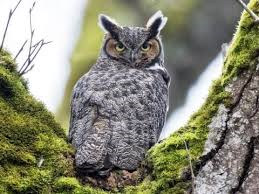Bird of the Week: Great Horned Owl
 This stealthy predator is at the top of the food chain. The Great Horned Owl’s wing structure allows it to silently sneak up on prey and deal a deadly blow with the force of their talons. Their adaptability to different habitats and large range of prey makes them one of the most common owl species in North America. This explains the common use of their appearance and call in the media. Their large, round body with two tufts, yellow eyes, and their four to five hoot call identify them as the mascot of owls in North America. As a primarily nocturnal species they are typically heard more than seen out in the wild, but you may get a glimpse of them out for an early hunt through the help of one of their favorite prey. The American Crow is always on the lookout for their top predator and will alert the surrounding forest of the presence of a Great Horned Owl out during the day. If you’re out hiking and the crows start calling, follow the sound of the crow’s “caw” and you might just spot an owl. To help you identify what you may be hearing in the woods at night visit https://www.allaboutbirds.org/guide/Great_Horned_Owl/sounds to listen to the Great Horned Owls hoot. To encourage one to take up residence in your backyard you can install a nest box, you can find the information and construction plans here.
This stealthy predator is at the top of the food chain. The Great Horned Owl’s wing structure allows it to silently sneak up on prey and deal a deadly blow with the force of their talons. Their adaptability to different habitats and large range of prey makes them one of the most common owl species in North America. This explains the common use of their appearance and call in the media. Their large, round body with two tufts, yellow eyes, and their four to five hoot call identify them as the mascot of owls in North America. As a primarily nocturnal species they are typically heard more than seen out in the wild, but you may get a glimpse of them out for an early hunt through the help of one of their favorite prey. The American Crow is always on the lookout for their top predator and will alert the surrounding forest of the presence of a Great Horned Owl out during the day. If you’re out hiking and the crows start calling, follow the sound of the crow’s “caw” and you might just spot an owl. To help you identify what you may be hearing in the woods at night visit https://www.allaboutbirds.org/guide/Great_Horned_Owl/sounds to listen to the Great Horned Owls hoot. To encourage one to take up residence in your backyard you can install a nest box, you can find the information and construction plans here.
